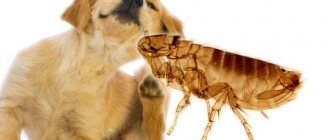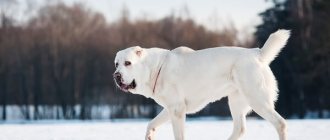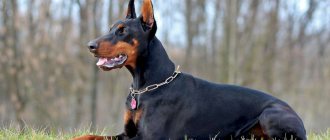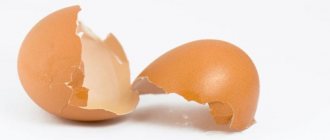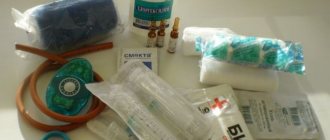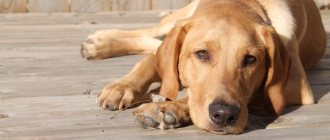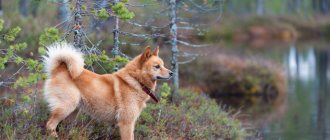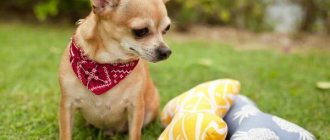Restless dogs, due to their high level of physical activity, are injured more often than other pets. Damage can be either harmless or severe. In any case, do not panic - timely and competent actions of the pet owner will help avoid serious consequences. First aid involves examining and treating the injury, and any dog owner needs to be able to do this.
Types of wounds in dogs
The choice of treatment method and drug for treatment directly depends on the type of wound and its characteristics. The following varieties are distinguished:
- Abrasions and scratches. They occur most often in life, usually observed on the back and paws. Formed during walks and active games in the house. Peroxide or antiseptic is suitable for processing. They pass quickly due to the high regeneration in dogs.
- Cut and chopped. They have smooth edges and can be complicated by severe bleeding. An important condition is to apply a tourniquet and then a sterile bandage. The treatment period depends on the depth of the lesion and the health of the animal. Sutures are recommended.
- Torn and bitten. Their danger is that muscle fibers and tendons can be affected. They have jagged surface edges on which dirt quickly accumulates. If the dog is bitten by another dog, stitches and antibiotics are required.
Less common than others are gunshot wounds. Their severity depends on the depth of penetration and the ammunition used. Urgent removal of lead from the body is required, as well as hardware diagnostics in order to notice damage to internal organs in time. Treatment at home is not recommended; you should contact a veterinary clinic. After fights, combined injuries can also occur. Because fangs easily bite through tissue, and jaw movements tear them apart.
Additional techniques
In addition to general and local treatment of trophic ulcers, veterinarians prescribe symptomatic therapy. Dogs are prescribed immunomodulators, multivitamin and mineral complexes, anabolic hormones, medications that improve microcirculation (trental, doxium), and enzyme agents . Alternative medicine will help speed up the healing of trophic ulcers.
Remember! The attending veterinarian will select the optimal effective therapy. You should not self-medicate if you do not want to worsen the condition of your beloved pet. Treatment of trophic ulcers in dogs requires a systematic, correct, comprehensive approach.
List of medications for treating wounds in dogs
The owner of any dog must have a first aid kit with medications to treat his pet. It should always contain a bandage, adhesive tape and an elastic band. The most necessary tools for processing:
- Hydrogen peroxide. Used to stop minor bleeding. Suitable for initial treatment of abrasions or shallow scratches. It is toxic, 1-3% peroxide is for external use only.
- Chlorhexidine. A universal antiseptic necessary for disinfecting all types of wounds on dogs. The solution is useful for preventing suppuration of sutures after surgical operations. Suitable for treating a wound on the paw after a walk.
- Miramistin. Antiseptic solution with weak antimicrobial and anti-inflammatory effects. Suitable for working with any wounds, has low toxicity. Available in the form of a 0.01% solution; no need to dilute with water before application.
- Furacilin. This is an antibacterial drug in tablet form. An indispensable remedy for treating weeping and festering injuries, as well as lacerations. To prepare the medicine, dilute 1 tablet in 100 ml of warm water.
- Terramycin. The advantage of this product is its aerosol form, which is convenient to use for active pets. The drug is an antibiotic. It is prescribed for treating fresh wounds after a fight or cat attack.
For weeping damage, it is recommended to use drugs in powder form, for example, Edis, Gentaxan and Iodoform. They not only destroy pathogenic bacteria, but also dry out the tissue. To speed up healing after a cut, you can use veterinary drugs in the form of ointments: Levosin, Panthenol, Fastin and Ranosan.
Iodine and brilliant green cannot be used to treat dogs. They can cause burns and dry out the skin. It is better to replace them with the drug Fukortsin. You should not use various folk remedies, for example, birch tar - this can cause complications and the departure of the dog.
First aid
When a dog is injured, certain measures are required on the part of its owner:
- First, treat the wound with a solution of hydrogen peroxide, potassium permanganate, furatsilin or chlorhexidine. If you don’t have these products in your home medicine cabinet, you can use clean running water.
- Shave or trim the hair around the wound.
- Lubricate the area around the wound well with iodine or Monclavit-1 (a modern disinfectant preparation based on iodine).
- Try to stop the bleeding using a homeostatic bandage and tight bandaging.
After these actions, preferably without the slightest delay, even with a seemingly trivial wound, you need to show the animal to a veterinarian. After all, poor-quality treatment or incorrect actions by the owner of a four-legged pet can lead to various complications. And with bleeding, any delay could even cost his life.
Features of treating wounds in dogs
Depending on the cause of the injury, its external manifestations and the health of the pet, treatment may vary. You should not choose medications, their dosage and frequency of use on your own without consulting a qualified veterinarian. However, it is worth knowing how and how to provide first aid before seeing a veterinarian.
How to treat a superficial wound?
Shallow and small superficial wounds can be treated at home yourself. As a rule, they heal well without causing complications. Step-by-step algorithm of actions:
- Wear gloves or wash your hands with antiseptic. Carefully clean the surface from dirt and foreign bodies. Use tweezers if necessary.
- Soak a cotton pad in a solution of Chlorhexidine. Apply light movements to the damaged area.
- Remove hairs and fur around the wound with scissors, and once again treat the edges with an antiseptic.
- Cover the area with a gauze bandage or bandage. If your pet is very active, wear a collar.
To stop minor bleeding, it is enough to treat the wound with cotton wool moistened with hydrogen peroxide. During this, it is recommended to lightly press the blood vessel with your finger. If the wound bleeds a little, the bandage should be bandaged more tightly. If the dog does not allow the wound to be treated, try to distract it with a treat or attract a second person to hold it, after putting on a muzzle.
Photo: flickr.com
How to treat a lacerated, weeping wound?
Lacerations are often accompanied by severe inflammation and complicated by bacterial infection. After pre-treatment, it is recommended to consult a doctor as soon as possible for suturing - this is the best way to prevent complications. The algorithm for initial treatment is the same as for superficial lesions.
Even after surgery, exudate – purulent contents – may appear, which causes weeping areas to appear. Treatment in this case is aimed at removing pus and dried crusts. To do this, apply a drug with an antibiotic, for example, Levomekol, Terramycin or tetracycline ointment, to the wound 1-2 times a day. If the dog has itching, give ¼ of an antihistamine tablet, for example, Tavegil or Suprastin.
The course of treatment with antibiotics is 10-14 days. During this period, you need to systematically wash the wound with an antiseptic medication, do not allow your pet to lick the affected area, and also limit physical activity. Depending on the depth and area of the lesion, healing may take up to 1 month.
Photo: mspca.org
What to do with open and deep wounds?
If you find a deep wound on your dog, you need to provide first aid as soon as possible. To do this, wash the surface with an antiseptic solution, cut off the fur around it and try to stop the bleeding. In case of severe bleeding, apply a tourniquet for 10-15 minutes, while simultaneously removing excess with a cotton pad or swab. After this, rinse the wound generously with Chlorhexidine, bandage it with a bandage and consult a veterinarian, since open and deep injuries require suturing.
If, with an open wound, there is damage to an artery in the neck or leg, it must be tightly closed with a finger without letting go of the hand. Bring your dog for surgery as soon as possible. Large vessels are amenable to surgical intervention if the operation is performed in a timely manner.
Treatment comes down to caring for the surface - removing dirt and dry crusts. To treat a purulent wound, antibiotics are prescribed. The course of therapy can take up to 1.5 months; during this period it is important to closely monitor the behavior and general well-being of the pet. Be sure to adjust your diet and limit physical activity at home and outside. If the dog constantly licks the seams, use an Elizabethan collar.
Purulent processes and recommended antibiotics
Often purulent processes begin to develop in the wound canal, which are accompanied by the formation of exudate and the manifestation of characteristic symptoms:
- A sharp increase in body temperature;
- Apathy;
- Weakness;
- Lack of appetite.
Indifference to food and apathetic mood indicate a deterioration in the dog’s condition
To eliminate undesirable consequences, the veterinarian must select suitable antibacterial medications that will help quickly cope with inflammation and suppuration of the injury. Effective and widely used drugs are:
- Cephalosporins - Cephalen, Cephalex, and Cefotaxime;
- Penicillins - “Sinulox”, “Ampicillin” and “Amoxicillin”;
- Tetracyclines – “Doxycycline”.
Broad spectrum antibiotics can be found in every pharmacy at an affordable price
As a rule, the course of therapy lasts no longer than two weeks. It should be noted that it is forbidden to apply sutures to wounds complicated by infectious microflora
Feeding a dog after injury
If the wound is shallow, healing occurs very quickly, without causing disruption to behavior and normal lifestyle. If there is serious tissue damage, the diet should be changed. First of all, provide the animal with plenty of water with constant access to it. Limit portions by dividing meals into 3-5 times a day. It is not recommended to change the diet, especially switching your pet from natural food to dry food and vice versa.
Veterinarians recommend purchasing a complex vitamin supplement, which will help speed up the regeneration process and strengthen the immune system. If your dog eats natural food, be sure to include in the daily diet as many vegetables as possible, which contain vitamins A and E - they are necessary for the normal functioning of epidermal tissues.
Photo: petsworld.in
Fighting cats
Cats are also at risk. Free-roaming pets can be attacked by other cats into whose territory they accidentally wander, or by other people's dogs. Don’t forget about rodents and hedgehogs, which also pose a significant threat, especially for cats that love to hunt small animals.
Medical battalion at home. How to organize treatment for a pet Read more
What to do if the wound does not heal
If the wound does not heal for a long time, you should understand the reasons for this process. A similar feature occurs in older animals and bitches after childbirth, since their immunity is weakened. To speed up regeneration, it is necessary to increase the number of treatments, as well as include wound-healing drugs in the form of ointments, for example, Panthenol or Levosin, in the treatment.
Often, tissue damage does not heal if the dog constantly licks or scratches it. To avoid this, be sure to wear a collar and cover it with a bandage. Limit active games and walks outside as much as possible. If there are no results for more than a month, suppuration appears, contact a veterinarian.
What danger do they pose?
An active dog sometimes gets into fights, and even a well-mannered pet can become a victim of an attack by stray animals. A four-legged friend can step on glass or other sharp objects or get caught on something both outdoors and indoors. An animal is not always able to discern danger, so responsibility for its safety lies entirely with the owner.
Try to choose safe walking routes, look through the clearings where your pet frolics for the presence of cutting and piercing objects. Do not let your dog get into a fight or be attacked by other dogs, because a stranger or stray animal can not only injure your four-legged friend, but also infect him with rabies.
If the injury is severe, the dog may lose a lot of blood. Large wounds require suturing of the skin. A lacerated wound in a domestic dog can take a very long time to heal, suppuration is possible, as well as more severe consequences such as sepsis and even gangrene.
Briefly about the main thing
- Dogs are susceptible to various injuries due to their activity. Wounds can be punctures, cuts, lacerations. Common abrasions and scratches are more common.
- Minor damage is enough to rinse and treat with an antiseptic. For deep wounds, you must first stop the bleeding, then disinfect the surface and consult a doctor.
- To treat weeping and lacerated wounds, antibiotics are prescribed for up to 14 days. This avoids suppuration and necrosis.
- If the damage does not heal, it is necessary to use wound healing drugs.
Have you ever experienced wounds on your dog? Share in the comments how to provide first aid to your pet.
Did you like the article? Share it with your friends on social media. networks. This will help them get useful information and support our project.

